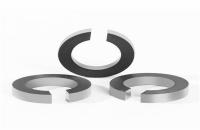
Low-noise cores are critical components in modern power equipment, special transformers, and precision instruments. With increasing demands for high efficiency and stable operation, noise issues caused by cores have become a major challenge. Low-noise cores effectively reduce vibration and noise pollution during operation, enhance equipment performance, and meet environmental and comfort standards. Therefore, optimizing material selection and manufacturing processes for cores is essential.
The magnetic properties of the material directly impact the noise performance of the core. When selecting materials, factors such as magnetic permeability, iron loss, and mechanical properties must be considered. Silicon steel sheets are the most commonly used core materials, particularly low-loss grain-oriented silicon steel and non-grain-oriented silicon steel, due to their excellent magnetic permeability and low loss characteristics. Additionally, advanced materials like nanocrystalline alloys and amorphous alloys have gained significant attention in recent years for low-noise cores. These materials offer lower magnetostriction coefficients and better flexibility, which help reduce vibration and noise while improving overall efficiency.

Manufacturing processes play a decisive role in the performance and noise level of cores. During processing, minimizing stress concentration and avoiding mechanical damage are critical. For instance, using laser cutting or precision punching during the cutting of silicon steel sheets can reduce edge damage and maintain magnetic properties. During the stacking process, optimizing the stacking method and fastening techniques can reduce mechanical stress and magnetostriction-induced noise. Additionally, applying coating technology to the core surface not only reduces iron loss but also further suppresses noise.
Accurate noise testing of cores after production is a crucial step in optimizing manufacturing processes. Vibration and sound pressure level tests can quantify the noise performance of cores under different working conditions, providing data support for further improvements. To verify the effectiveness of material and process improvements, computer simulation technology can be used to model core noise levels under various process conditions, guiding practical production. By analyzing test data, adjusting material composition, and refining process parameters, the ultimate goal of low noise can be achieved.
With the growing demand for low-noise equipment, research on low-noise cores will continue to advance. Future directions include developing new composite materials that meet both low-loss and low-noise requirements, exploring more precise manufacturing processes such as 3D printing technology in core production, and leveraging simulations and AI-assisted tools for more efficient process optimization. Through breakthroughs in both materials and processes, low-noise cores will play an increasingly significant role in power equipment, contributing to a greener and more energy-efficient society.
Is it harmful to drink from a stainless steel thermos for a long time?
2023-03-01Stainless Steel Terms
2021-07-30What is silicon steel?
2022-09-14Popular Material For Straps - Stainless Steel Material
2022-08-29Effect of 304L stainless steel surface drawing oxidation
2024-06-05The artistic beauty of stainless steel corrugated board
2021-06-10






